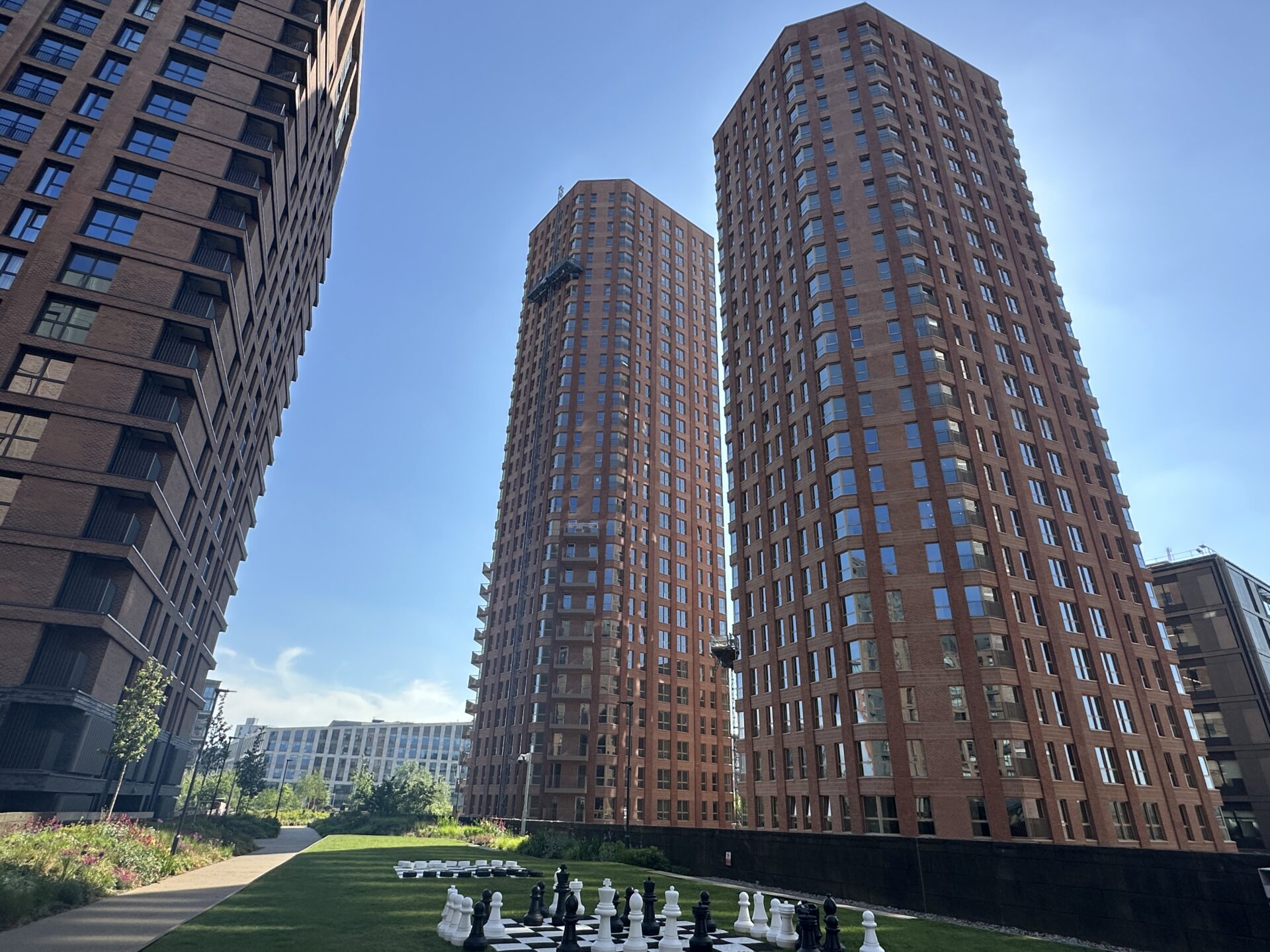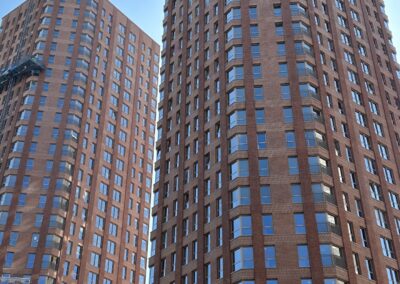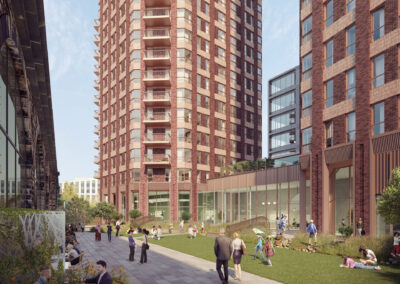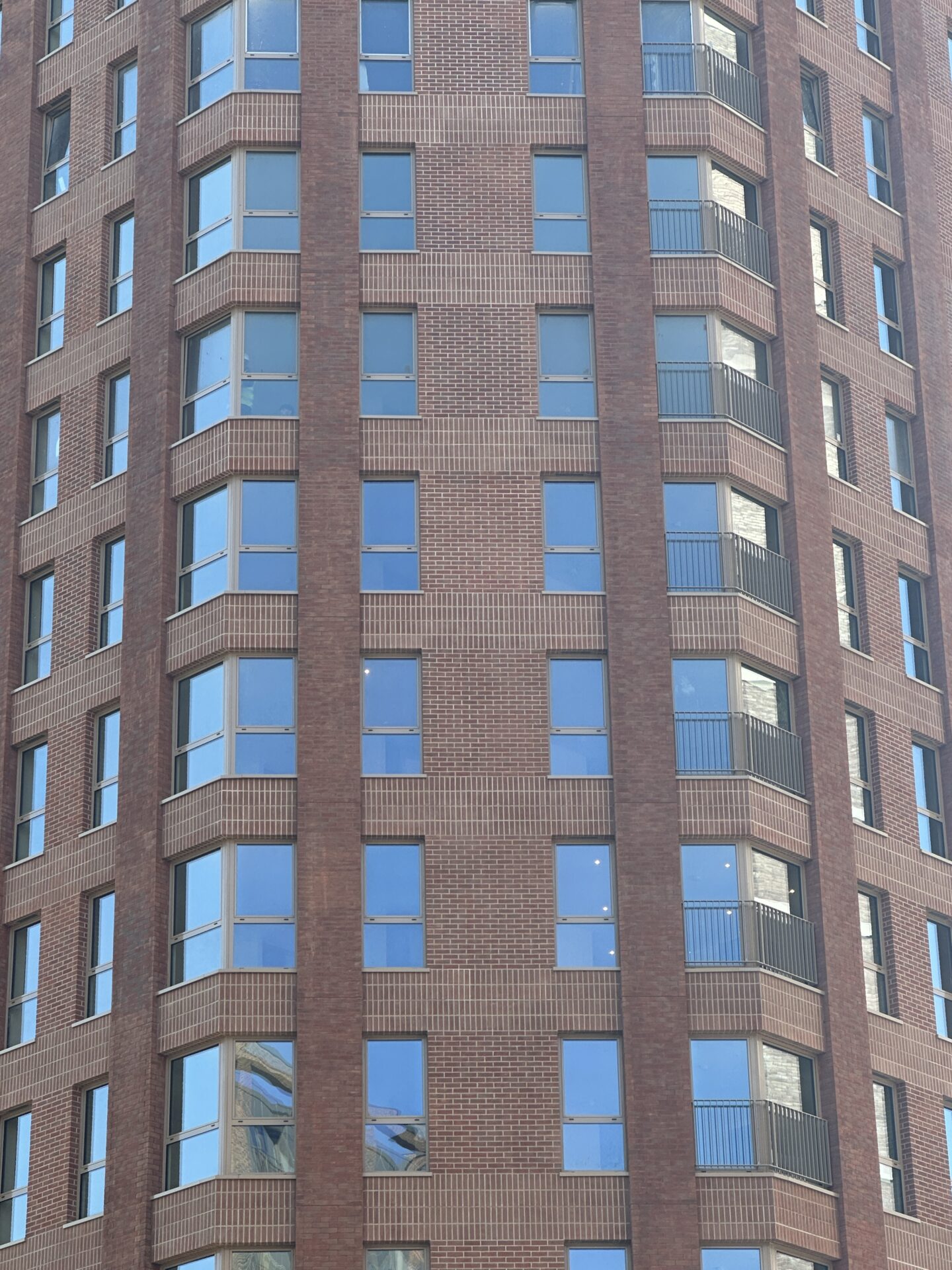INCA Case Study: Leeds II Urban Regeneration
Leeds II Urban Regeneration
Project Type: New Build
Building Type: High Rise, Residential
Architect: Carey Jones Chapman Tolcher
System Designer: Aliva UK
Installer: PIC Construction Group
System & Finish: AlivaBrick
U-Value Before: N/A
U-Value After: 0.11 – 0.16 W/m²K
A brick slip system leading the way for Leeds II
Leeds II is urban regeneration at its finest in West Yorkshire, marking a second phase of construction on the previous site of the Doncaster Monkbridge Iron and Steelwork.
It includes two landmark octagonal towers of 26 and 31 storeys, bringing 488 apartments into the Build to Rent market for client HUB, a progressive developer whose mission is to create ‘living places for communities to thrive now and in the future’.
The project is located on the Leeds to Liverpool canal and includes a new public realm area that will improve pedestrian and cycle routes into the city centre.
HUB is committed to creating low carbon urban living. This helped make Aliva UK’s External Wall Insulation brick slip system, AlivaBrick, the perfect sustainable choice for the project. That is alongside the aesthetics and detailing deliverable through its brick slips, with stretcher and soldier bonds alongside vertical piers that pull the eye up the full height of the two towers to the sky.
Aliva UK is proud to have provided a customised EWI clay brick slip facade system with several impressive accent details to create architectural flair with a brickwork aesthetic utilising Modern Methods of Construction (MMC).
A fully bespoke solution, the AlivaBrick system met all elements of the architectural design brief without compromise. It can be installed without height restriction, which made it the optimum facade solution given the heights of this two-tower new-build project, the highest in the west of Leeds city centre.
Architectural intent: This customised system realised architect Carey Jones Chapman Tolcher’s design intent without compromise. A deliberate choice of a small complementary palette of colourways have created maximum impact and style, with points of brick slip flair including stretcher and soldier bonds and verticality of piers that guide the eye from ground to crown, up to the city skyline.
Small palette big impact: Aliva UK has designed and supplied 10,000sqm of AlivaBrick for Leeds II, with red multi and buff multi clay slips and two colours of mortar to complement each slip colour. The mineral wool thicknesses include 140mm and 250mm and the clay slips are 15mm thickness.
A small slip colour palette that packs big impact, AlivaBrick creates flair but is also sympathetic to the urban heritage of the city with its traditional brickwork aesthetic. It creates high end kerb-appeal with empathy to the city’s urban past.
Octagonal towers and chamfers
The two towers are octagonal in shape, with chamfered corners, designed to create ‘softer lines/not hard edges’ as part of the city skyline and this development quarter, with the two octagons designed offset to avoid direct overlooking for residents.
Liam Crowther, Associate at Carey Jones Chapman Tolcher, said:
“The AlivaBrick slip system’s red and buff colourways blend into the new neighbourhood that is being created in this development quarter, tones sympathetic to the existing architecture and urban heritage yet able to make a stylish statement through the octagonal shaping and slip detailing possible with its brick slip system.
“The AlivaBrick colourways chosen for Leeds II feature a small palette that packs big impact, two brick slip and two mortar colours, have created architectural flair with an aesthetic that’s simple yet stylish, both effective and sympathetic to the neighbourhood that Leeds II is the latest addition to, the existing architecture and the locale’s urban heritage.
“Feature detailing includes stretcher and soldier bonds which demonstrates the versatility of this slip system in vertical and horizontal formats, creating the aesthetic of banding against the slips that then project verticality of the piers in turn. This achieves the design intent of creating visual intrigue, which then guides the eye up the full height of the building and to the crowning line that caps the two towers.”
Installation
INCA member PIC Construction Group was the installation contractor. The system was installed over a lightweight steel frame with a 12mm cement particle board to the outer-face. The lightweight studs were infilled with mineral wool and finished internally with a Vapour Control membrane and 2 layers of gypsum plasterboard.
The Aliva system was directly fixed using specified mechanical fixings, with the insulation layer installed board-by-board, including a cementitious levelling layer to the rear of the insulation. This allowed any tolerances within the frame to be adjusted, and a vertically level face provided for subsequent layers.
The required number of fixings were installed, using engineered wind calculations. Once the boards were installed reinforced cement basecoat layers were applied. The first, allowed the insertion of a reinforcing mesh, lapped to create a monolithic covering across the entire façade. This mesh was also mechanically fixed with stainless steel fixings and washers to comply with fire requirements and to provide additional robust mechanical fix to the system. Once the final layer of basecoat was applied and smoothed the basecoat was allowed to cure.
Once cured, the cement-based bedding mortar was applied to the surface and the 15mm clay slips installed by embedding the slips into the bedding mortar. Full embedment was achieved, ensuring the clay slips had full surface area contact. This continued to achieve the brick façade. The slips were then pointed with a robust cement-based Aliva pointing grout and struck to achieve the final finish.
Fire safety: AlivaBrick has A1 fire rating and Kiwa UK certification. It has been developed to ensure the highest fire classification has been achieved based on testing to standard EN 13501-1:2019, the recognised linear route to regulatory compliance. It can be installed without height restriction, which made it the optimum façade solution given the heights of this two-tower new-build.
U-Values: The project had several detail interfaces, however, the U-Value ranges achieved were between 0.11-0.16 W/m2k, inputted into the final thermal calculations for the entire building.
Sustainability: AlivaBrick reduced material and weight on the project plus brick slip production requires approximately 85% less energy than conventional brick production, adding to the NZC contribution.
What the client said:
“We wanted the two octagonal towers that form this flagship build as part of this new residential quarter in Leeds to reflect the strong industrial history of the area, while also meeting very high sustainability aspirations.
“We needed a cladding solution that combined aesthetics with sustainability and high performance, and this Aliva EWI brick slip system has created impressive U-Values, between 0.11-0.16 W/m2k, with the added benefit of reducing time on-site.
“Aesthetically, the two tones of brick slip and mortar have created vertical and horizontal detailing, creating architectural interest with a subtlety that is in-keeping with the neighbouring buildings as well as the urban heritage of the city.”
Victoria Manston, Head of Development, HUB
Aesthetically, the two tones of brick slip and mortar have created vertical and horizontal detailing, creating architectural interest with a subtlety that is in-keeping with the neighbouring buildings as well as the urban heritage of the city.”










